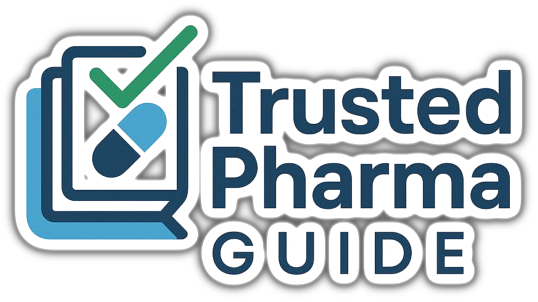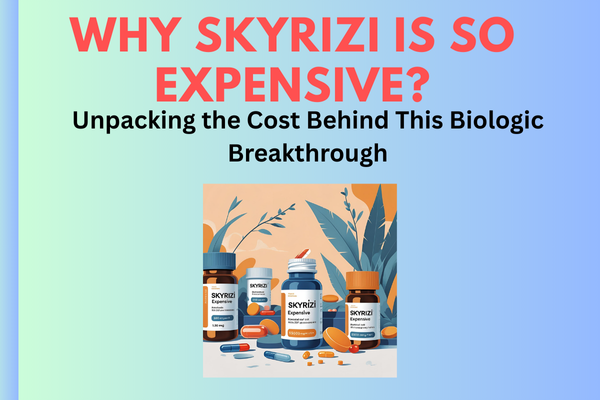Table of Contents
Introduction
Skyrizi (risankizumab) is one of the most talked-about biologics in recent memory, offering life-changing relief for people with plaque psoriasis, psoriatic arthritis, and Crohn’s disease. However, its clinical success comes at a steep price — often $70,000 to $80,000 per year. Understandably, patients, caregivers, and even healthcare providers continue to ask: Why Skyrizi is so expensive? The answer is multifaceted. It’s about the science, the product’s complexity, the market’s specificity, and the dynamics of the healthcare system. But before we break down the costs, it’s important to understand what Skyrizi is, how it works, and the risks it poses.
1. What Is Skyrizi?
Skyrizi is the brand name for the prescription drug risankizumab-arza, which is classified as a biologic. It is manufactured by AbbVie and is approved by the U.S. Food and Drug Administration (FDA) for:
• Moderate to severe plaque psoriasis in adults
• Active psoriatic arthritis in adults
• Moderate to severe Crohn’s disease in adults
Skyrizi is given by subcutaneous injection, usually every 12 weeks after an initial loading schedule. This infrequent dosing is one reason it is preferred over other biologic drugs that require monthly or even biweekly injections.
For patients suffering from chronic, immune-mediated inflammatory diseases, Skyrizi can mean not only symptom control but also long-term remission.
2. Mechanism of Action (MOA)
One of the main reasons why Skyrizi is so expensive is its targeted mechanism of action.
• Skyrizi is a humanized monoclonal antibody.
• It specifically binds to the p19 subunit of interleukin-23 (IL-23) – a cytokine that plays a key role in inflammation and immune system regulation.
• By blocking IL-23, Skyrizi disrupts signaling pathways that trigger overactive immune responses.
This selectivity makes Skyrizi highly effective with fewer systemic side effects than older treatments. But producing such a precision biologic is technically challenging and expensive.

3. Side Effects of Skyrizi
While Skyrizi is generally well-tolerated, it can still cause side effects.
Common side effects:
- Upper respiratory tract infections (cold, sinusitis)
- Headache
- Fatigue
- Injection site redness or swelling
- Fungal skin infections
Serious side effects:
- Allergic reactions (rash, swelling, breathing difficulty)
- Increased risk of serious infections (tuberculosis, pneumonia)
- Liver problems (yellowing skin/eyes, dark urine)
Patients are usually screened for infections before starting treatment and are monitored closely afterward.
4. The Science and Cost of Biologics
Biologics are not like regular pills. They are made using living cells in a highly controlled laboratory environment. Production requires:
• Specialized cell lines
• Complex purification processes
• Strict temperature and contamination controls
• Rigorous quality testing
That’s why biologics like Skyrizi are much more expensive to produce than traditional small-molecule drugs. Development costs are also enormous — often more than $1 billion from research to regulatory approval.
5. The Price Tag: Breaking Down the Numbers
When you ask patients why Skyrizi is so expensive, they often give these surprising numbers:
• Wholesale Acquisition Cost (WAC) per dose: ~$22,383.49
• Annual maintenance treatment: $70,000–$80,000
• First-year cost: Can be over $88,500 (due to loading dose)
• Cost without insurance: ~$31,096 per dose
These are list prices. Many patients don’t pay the full amount, but the sticker price shapes insurance negotiations and affects uninsured patients the most.
6. Why Skyrizi Is So Expensive? Key Factors
Costs are not limited to making the drug. Several factors come together:
1. Patent protection – Skyrizi is protected from biosimilar competition until at least 2029. Without generics or biosimilars, AbbVie controls the price.
2. Market position – Skyrizi is marketed as the “best” biologic with superior dosing convenience and long-term effects.
3. U.S. drug pricing system – Allows U.S. manufacturers to set high launch prices without direct government regulation.
4. Distribution markups – Wholesalers, pharmacies, and pharmacy benefit managers (PBMs) add layers of cost.
5. Corporate strategy – Skyrizi is replacing Humira as AbbVie’s top seller, generating billions in revenue.
7. How AbbVie Keeps Prices High
AbbVie’s pricing strategy reflects both patient needs and business priorities:
• Skyrizi and its sister drug Rinvoq are projected to generate more than $31 billion in revenue annually by 2027.
• With Humira’s patent expiring, AbbVie relies heavily on Skyrizi’s premium pricing to maintain profitability.
• In the second quarter of 2025 alone, Skyrizi generated sales of $4.42 billion.
8. Assistance Programs to Reduce the Cost
While it’s a valid question why Skyrizi is so expensive, patients often pay much less thanks to assistance programs:
• Skyrizi Complete Savings Card – Eligible insured patients can pay $0 per dose up to four times a year.
• myAbbVie Assist – Provides free or discounted medication for uninsured or low-income patients.
• Medicare/Medicare – Reduces costs to as little as $10/month or caps annual costs.
Real-world example:
“The makers of Skyrizi, AbbVie, have a program where they will provide up to two years of medication if your insurance doesn’t cover it.” – Patient feedback from Reddit.
9. Insurance and Negotiation Tips
To increase affordability:
• Ask your provider to submit a prior authorization with detailed medical requirements.
• Explore specialty pharmacy options—some offer lower negotiated rates.
• Apply for all available manufacturer and non-profit programs.
10. The Bottom Line
Why Skyrizi is so expensive?
Because it is a patented, highly targeted biologic drug with expensive manufacturing, billions of dollars in development costs, and a strategic price in a healthcare system that allows for premium rates.
While the sticker price is shocking, the reality is that many patients qualify for significant cost reductions. Still, until biosimilar competition arrives or policy reforms are made, Skyrizi will remain one of the more expensive biologics on the market.
Frequently Asked Questions (FAQ)
1. What is Skyrizi used for?
2. Why Skyrizi is so expensive compared to other treatments?
3. How often is Skyrizi taken?
4. Are there side effects to Skyrizi?
5. Does insurance cover Skyrizi?
6. Are there generic or biosimilar versions of Skyrizi?
7. Can patients without insurance afford Skyrizi?
Disclaimer
This article on Why Skyrizi Is So Expensive ? is for educational purposes only and does not replace professional medical advice. Always consult a qualified healthcare provider before starting, changing, or stopping any medication, including Skyrizi. Pricing and assistance program details may change over time—verify with official sources or your healthcare team.

